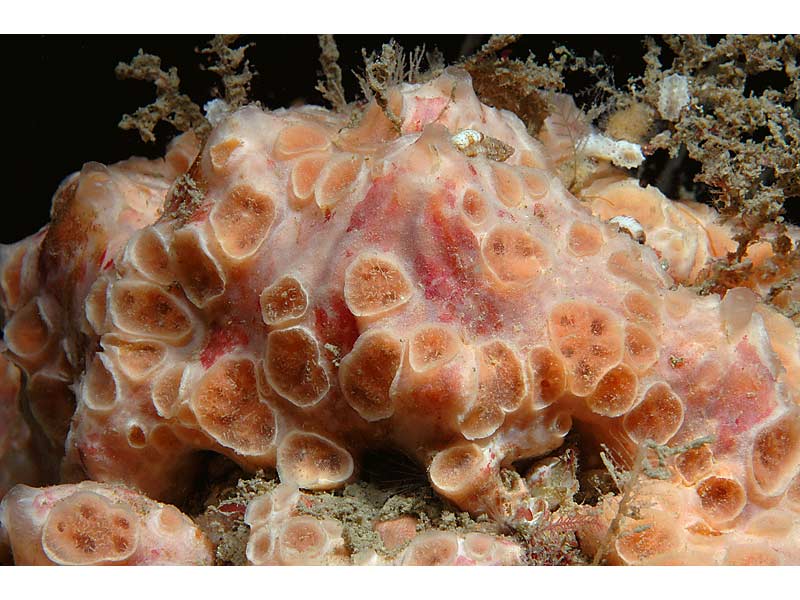Crater sponge (Hemimycale columella)
Distribution data supplied by the Ocean Biodiversity Information System (OBIS). To interrogate UK data visit the NBN Atlas.Map Help
| Researched by | Saskiya Richards | Refereed by | Admin |
| Authority | (Bowerbank, 1874) | ||
| Other common names | Honeycomb sponge | Synonyms | - |
Summary
Description
Hemimycale columella is a sessile sponge that forms a thick encrusting layer of at least 1 cm, and reaches widths of up to 30 cm. It has a fairly soft texture, a skeleton of siliceous spicules (spines) and spongin fibre. The surface of Hemimycale columella has a honeycomb appearance created by numerous cavities, the rims of which are supported by the spicules. Within each of the cavities is at least one small, inhalant pore (oscula) of up to 0.1 cm in diameter. In general the oscula are infrequent. Hemimycale columella is distinguished from similar species by its large megascleres (spicules) that are club-shaped at the ends, and by the absence of smaller spicules.
Recorded distribution in Britain and Ireland
Hemimycale columella has a widespread distribution from south-east England to northwest Scotland, including the southern, western and northern Irish coasts. It has not been recorded from the North Sea coast except at Blyth.Global distribution
Hemimycale columella is distributed from the Artic and the British Isles to France and the Mediterranean.Habitat
Hemimycale columella is epilithic and found attached to hard substratum, such as clean rock, boulders, cobbles, stones and shingle. It is found on the lower shore and in the sublittoral zone, its optimal development being within the kelp zone. It is not found in harbours.Depth range
-Identifying features
- Thick encrusting texture.
- Surface characterised by depressions which create a honeycomb appearance.
- Colour varies from bright red to pale orange or pink.
- Depression craters highlighted by a lighter-coloured ridge.
Additional information
In its encrusting form Hemimycale columella grows outwards from the edge of the colony. However, this species also exhibits an irregular massive form in which growth takes place on the surface. When disturbed, the oscules contract within approximately 15 seconds - (Forester, 1955). Both reproduction and growth are dependent on the time of season. Hemimycale columella is a filter-feeder, using internal choanocytes to circulate water through its pores.
The taxonomy of Hemimycale columella is unclear with some authorities placing it in the Haliclonidae family, others in the Biemnidae with Biemna variantia. This species can be mistaken for Phorbas fictitus which lacks a light-coloured circle around the depression craters.
Listed by
- none -
Bibliography
Ackers, R.G., Moss, D., Picton, B.E. & Stone, S.M.K., 1985. Sponges of the British Isles (sponge IV): a colour guide and working document. , Ross on Wye: Marine Conservation Society.
Fish, J.D. & Fish, S., 1996. A student's guide to the seashore. Cambridge: Cambridge University Press.
Forster, G.R., 1955. Hemimycale columella (Bowerbank): a short description and history of the species. Journal of the Marine Biological Association of the United Kingdom, 34, 553-557.
Foster-Smith, J. (ed.), 2000. The marine fauna and flora of the Cullercoats District. Marine species records for the North East Coast of England. Sunderland: Penshaw Press, for the Dove Marine Laboratory, University of Newcastle upon Tyne.
Hayward, P., Nelson-Smith, T. & Shields, C. 1996. Collins pocket guide. Sea shore of Britain and northern Europe. London: HarperCollins.
Hayward, P.J. & Ryland, J.S. (ed.) 1995b. Handbook of the marine fauna of North-West Europe. Oxford: Oxford University Press.
Howson, C.M. & Picton, B.E., 1997. The species directory of the marine fauna and flora of the British Isles and surrounding seas. Belfast: Ulster Museum. [Ulster Museum publication, no. 276.]
Picton, B.E., & Costello, M.J., 2001. BioMar biotope viewer: a guide to marine habitats and fauna of Britain and Ireland. http://www.itsligo.ie/biomar/echinode/ECHSEP.HTM, 2001-06-01
Datasets
Centre for Environmental Data and Recording, 2018. Ulster Museum Marine Surveys of Northern Ireland Coastal Waters. Occurrence dataset https://www.nmni.com/CEDaR/CEDaR-Centre-for-Environmental-Data-and-Recording.aspx accessed via NBNAtlas.org on 2018-09-25.
Manx Biological Recording Partnership, 2022. Isle of Man historical wildlife records 1990 to 1994. Occurrence dataset:https://doi.org/10.15468/aru16v accessed via GBIF.org on 2024-09-27.
NBN (National Biodiversity Network) Atlas. Available from: https://www.nbnatlas.org.
OBIS (Ocean Biodiversity Information System), 2025. Global map of species distribution using gridded data. Available from: Ocean Biogeographic Information System. www.iobis.org. Accessed: 2025-07-22
South East Wales Biodiversity Records Centre, 2023. SEWBReC Marine and other Aquatic Invertebrates (South East Wales). Occurrence dataset:https://doi.org/10.15468/zxy1n6 accessed via GBIF.org on 2024-09-27.
Citation
This review can be cited as:
Last Updated: 03/07/2008




